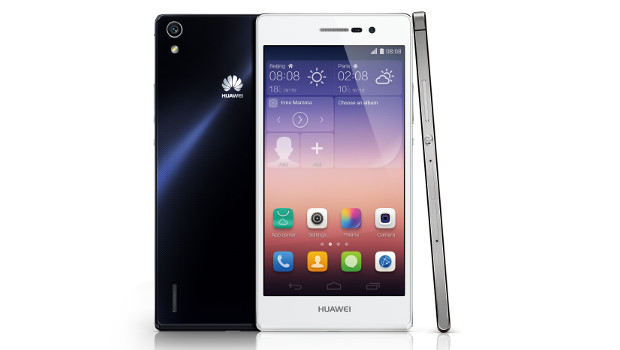Huawei has been quietly growing in confidence and capability in the smart phone market, as last year’s Ascend P6 showed. This year, the Chinese giant has gone one better with the P7 which firmly puts it in the premium bracket.
The first thing that strikes you when you pick up the P7 is its lightness. At 124g, it is lighter than either the Galaxy S5 (145g) or HTC One M8 (160g) and pretty close to the iPhone 5s (112g), despite being considerably larger than the latter at 139.8 x 68.8 x 6.5 mm. By comparison, our benchmark currently is the Google Nexus 5, courtesy of Google. It weighs 130g in a 137.9 x 69.2 x 8.6 mm package. So the P7 is slim too
The next thing of note is the build quality and finish. A surround of brushed aluminium and neatly curved edges, along with a seven layer Gorilla glass back give it a very classy look, along with a very small front bezel giving full reign to the gorgeous screen.

At just 6.5mm thick, the P7 is very slim compared to Nexus 5. (Image: Mediateam)
The screen is the main reason for the fairly large dimensions, having a viewing diagonal of 127mm, or 5” in old money, at a full 1920 x 1080 resolution, with a 441ppi density. This puts it on a par with the M8 and ahead of the 5s and S5. The Nexus 5 is a similar spec, but slightly smaller at 126mm or 4.95”. This is pretty much characteristic of the P7 in that it excels here and there, slightly under performs elsewhere, and then turns up a few unique points that differentiate it from the crowd.
A minor gripe, though it must be said nothing that was ever noticed as a detriment in testing, are the limited Wi-Fi modes. Though it supports 802.11b/g/n, there is no mention of dual-band 802.11ac or dual-band 802.11n in the official spec sheet. This may be an issue as public Wi-Fi develops and people adopt on a two year contract, but in testing, Wi-Fi performed perfectly well.
But a key differentiator for the P7 comes from Huawei’s deep knowledge of the carrier network, it being one of the largest suppliers of 4G technology to the likes of Vodafone here in Ireland. The P7 has dual 4G antennae which means it can speak to multiples towers at once and maintain a signal where others fail. The other trick it has up its sleeve is being able to combine the antenna to achieve speeds of up to 150Mb/s over an LTE network. No other phone on the market can do this, though this kind of throughput would be dependent on the underlying network.
The other party trick, is that there is a MicroSD card expansion slot that doubles as a second SIM slot. This means that the P7 can function in full dual SIM mode. A regular international traveller? Especially to the US? No problem, have your cheap international or roaming SIM in the second slot ensuring you don’t get that awful post trip bill!







Subscribers 0
Fans 0
Followers 0
Followers